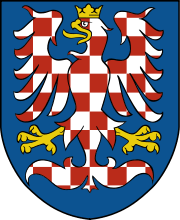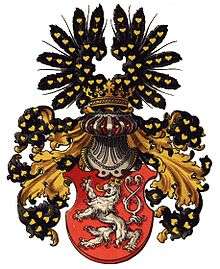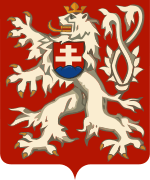Coat of arms of the Czech Republic
| Greater coat of arms of the Czech Republic | |
|---|---|
 | |
| Versions | |
|
Presidential version with the motto used on Czech Presidential Standard | |
| Details | |
| Armiger | Czech Republic |
| Adopted | 17 December 1992 |
| Escutcheon | Quarterly: first and fourth gules, a lion rampant queue forchée argent armed, langued and crowned Or (Bohemia); second azure, an eagle displayed chequé gules and argent armed, langued and crowned Or (Moravia); third Or, an eagle displayed sable armed and langued gules crowned of the field and charged on the breast with a crescent terminating in trefoils at each end with issuing from the centrepoint a cross patée argent (Silesia). |
| Compartment | The leaves of the linden tree and the red ribbon with the National Motto |
| Motto |
PRAVDA VÍTĚZÍ "TRUTH PREVAILS" |
| Lesser coat of arms of the Czech Republic | |
|---|---|
 | |
| Versions | |
|
Version used by the Chamber of Deputies | |
| Details | |
| Armiger | Czech Republic |
| Adopted | 17 December 1992 |
| Escutcheon | a lion rampant queue forchée argent armed, langued and crowned Or (Czech lands) |
The coat of arms of the Czech Republic (Czech: Státní znak České republiky) displays the three historical regions—the Czech lands—which make up the nation. The current coat of arms, which was adopted in 1992, was designed by Czech heraldist Jiří Louda.[1]
Background
 Bohemia and whole Czech lands
Bohemia and whole Czech lands

The arms of Bohemia show a silver double-tailed lion on a red background.[2] This Bohemian Lion makes up the first and the fourth quarters of the greater coat of arms, so it is repeated in the shield. The Moravian red-and-silver chequered eagle is shown on a blue background. Between 1915 and 1918 the Moravian Eagle was chequered in the red-and-gold colors. The arms of Silesia are a black eagle with the so-called "clover stalk" (lat. perisonium) in her breast on a golden background, although only a small south-eastern part of the historical region (Czech Silesia) belongs to the Czech Republic (the main part is now in Poland).
The rulers of Bohemia originally bore for arms a so-called St. Wenceslas flaming eagle. In the 12th century, Emperor Frederick granted new arms to King Vladislaus II consisting of a silver lion on a red field, to symbolise his valor. The lion was at first represented with one tail. Later a second tail was added, for the help provided by the King Přemysl Otakar II fighting the Saxons. [3]
The oldest surviving full color depiction of the arms of Bohemia appears in the Passional of Abbes Cunegund from the 1310s.[4] The Moravian Eagle was first documented on the seal of Ottokar's uncle, Margrave Přemysl (d. 1239). The Silesian Eagle stems from the ruling dynasty of the Piasts and was first applied by Duke Henry II the Pious (1238-1241). The shields also appeared on the emblems of the Crown of Bohemia established by Emperor Charles IV.
Today the greater shield is also used as the badge for the Czech national ice hockey team. On the other hand, Czech national football team is traditionally using just lesser Czech Lion.
Variants
Greater version
The greater coat of arms is blazoned in Czech law as follows:
A shield quartered: first and fourth gules, a lion rampant queue forchée argent armed, langued and crowned Or; second azure, an eagle displayed chequé gules and argent armed, langued and crowned Or; third Or, an eagle displayed sable armed and langued gules crowned of the field and charged on the breast with a crescent terminating in trefoils at each end with issuing from the centrepoint a cross patée argent.[5]
Lesser version
The lesser coat of arms is blazoned in Czech law.[6]
History
Graphic versions: |
Přemyslid dynasty (Duchy of Bohemia) |
Originals: | |
 |
Kingdom of Bohemia (Royal Arms of Bohemia) |
 | |
 |
Margraviate of Moravia |
 | |
 |
|||
|
Kingdom of Bohemia |
 |
||
|
Royal Arms of Bohemia by austrian heraldist Hugo Gerard Ströhl (1851-1919) |
 |
||
 (note: simple design)  (note: wrong crown on lion's head) |
Lesser Royal Arms of Bohemia |
 |
|
 |
Kingdom of Bohemia |
||
|
Another version by Hugo Gerard Ströhl with crown of Saint Wenceslas |
 |
||
 |
Lands of the Bohemian Crown |
||
.svg.png) |
Large coat of arms of Czechoslovakia (1918-1939) |
||
.svg.png) |
The large CoA of the Protectorate of Bohemia and Moravia |
||
 |
Czechoslovakia (1918-1960) |
||
.svg.png) |
Czechoslovakia (after 1961) |
||
 |
|||
See also
References and external links
| Wikimedia Commons has media related to Coats of arms of the Czech Republic. |
- ↑ Velinger, Jan (2015-09-02). "Heraldist, WWII vet, Jiří Louda dies at 94". Radio Prague. Retrieved 2015-09-28.
- ↑ Blazonied as gules, a lion rampant, queue fourchee argent, crowned, langued and armed or.
- ↑ LOUDA, Jiří: Království české: erby a rodokmeny vladnoucích rodů (Czech Kingdom: Coats of Arms and Family Trees of Governing Arostocratic Families) … Havířov : Petr P.Pavlík, 1996. s. 22-23. ISBN 80-85574-09-8.
- ↑ "Sbírka Národní knihovny ČR". ces.mkcr.cz. Ministry of Culture of the Czech Republic: Central Registry of Museum-type Collections. Archived from the original on 20 January 2015. Retrieved 12 January 2015.
- ↑ Original text of Czech statute 1993:3, 1 §, states: Velký státní znak tvoří čtvrcený štít, v jehož prvním a čtvrtém červeném poli je stříbrný dvouocasý lev ve skoku se zlatou korunou a zlatou zbrojí. Ve druhém modrém poli je stříbrno-červeně šachovaná orlice se zlatou korunou a zlatou zbrojí. Ve třetím zlatém poli je černá orlice se stříbrným půlměsícem zakončeným jetelovými trojlístky a uprostřed s křížkem, se zlatou korunou a červenou zbrojí.
- ↑ Original text of Czech statute 1993:3, 1 §, states: Malý státní znak tvoří červený štít, v němž je stříbrný dvouocasý lev ve skoku se zlatou korunou a zlatou zbrojí.
.svg.png)

